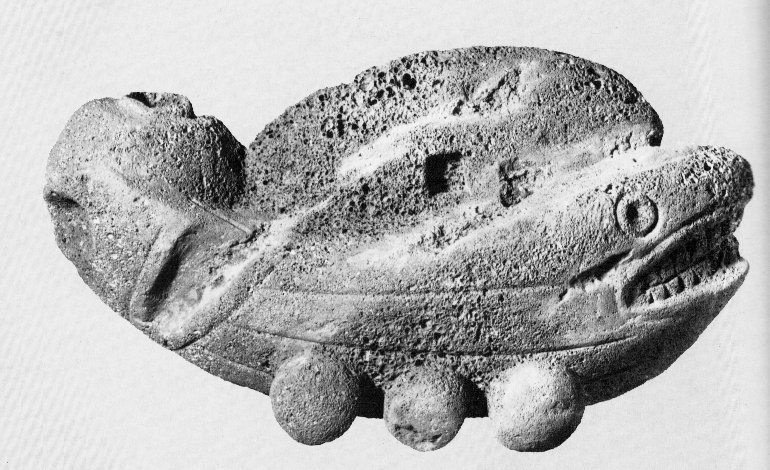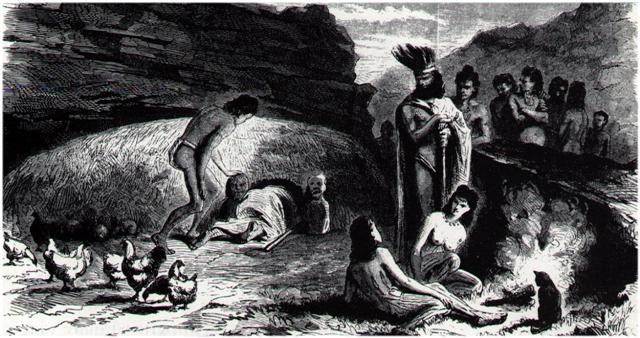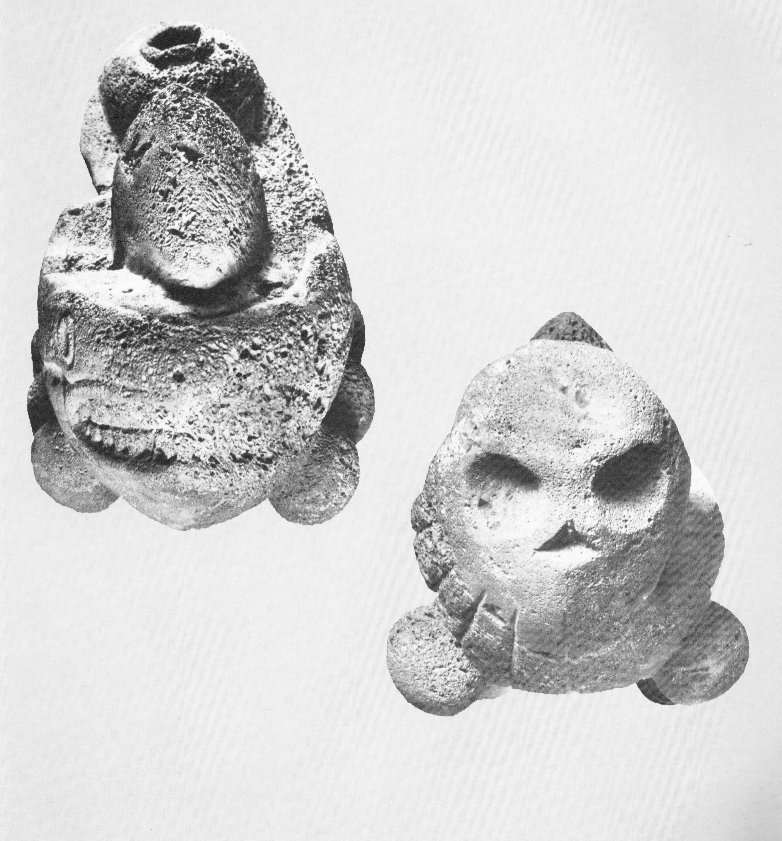|
TRANSLATIONS
|
4.
At this stage we have become accustomed to the fact that
glyphs mostly are composites, creations which ingeniously - and
often playfully - are using more or less subtle signs.
Nevertheless we would like to identify a glyph type with some known
entity, instead of being a collage. For ika hiku we can use
a mermaid's purse as a mental crutch:
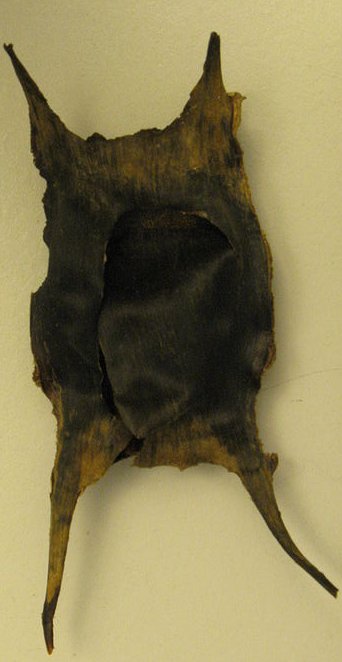
(Wikipedia: Mermaid's Purse - the egg case of a Raja
species.)

(Wikipedia: Mermaid's Purse - the egg case of a dogfish.)
"Mermaid's purses (also known as Devil's Purses) are the egg
cases of skates, sharks and rays. They are among the common
objects which are washed up by the sea. Because they are
lightweight, they are often found at the furthest point of
the high tide. The eggcases that wash up on beaches are
usually empty, the young fish having already hatched out."
(Wikipedia)
|
When the spring shark (vaha kai,
the youngest sun of king Hotua Matua) has eaten
enough it is time to spawn.
|
The Devil makes his appearance
again:
... In this
morning's
newspaper I was
surprised by the
coincidence of
finding an
important piece
of the puzzle. A
standing column
about the
meanings of
words today had
chosen as its
subject the name
of a fish, 'kolja'
in Swedish. I
translate:
... The word
kolja is
connected with
how the fish
looks. Along its
side runs a
black line, and
on each side
close to the
dorsal fin there
is a large black
spot. And these
black spots we
have apparently
associated with
coals [kol
in Swedish]. The
word can
probably be
derived from
kolugr,
black as coal.
I
can therefore
translate
Pe'i with
the Swedish
kolja. Both
fishes signify
darkness. If I
then translate
kolja
into English we
- amazingly -
arrive at
'haddock', and
the cycle is
closed. The name
shaddock has
survived because
it resembles
haddock - and
the connection
between a great
juicy fruit and
darkness must
once have been
evident for most
people. Maybe it
still is.
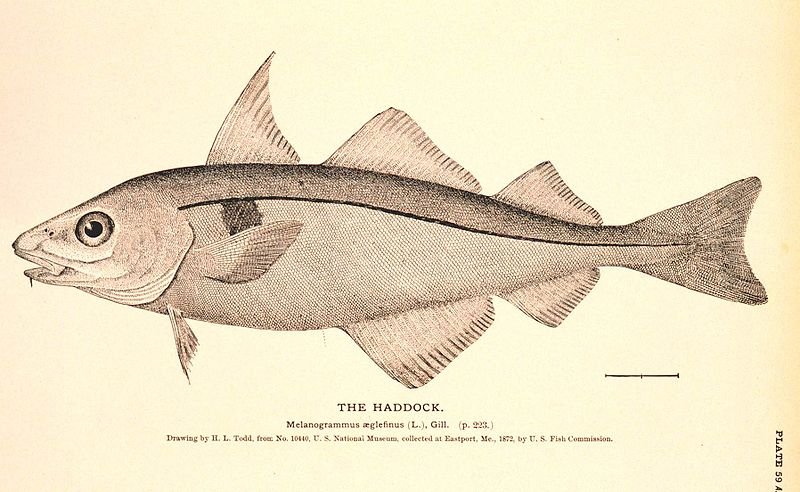
"The
haddock
or
offshore
hake is
a marine
fish
distributed
on both
sides of
the
North
Atlantic.
Haddock
is a
popular
food
fish,
widely
fished
commercially.
The
haddock
is
easily
recognized
by a
black
lateral
line
running
along
its
white
side
(not to
be
confused
with
pollock
which
has the
reverse,
i.e.
white
line on
black
side)
and a
distinctive
dark
blotch
above
the
pectoral
fin,
often
described
as a
'thumbprint'
or even
the
'Devil's
thumbprint'
or 'St.
Peter's
mark'
..."
(Wikipedia)
|
|
" ... Te Pei [one
of the kuhane
stations] should
probably read Te Pe'i
(unfortunately, Ms. E
does not indicate
glottal stops). The
pe'i is a large,
tasty fish (Caranx
cheilio, Fuentes
1960:290), caught in the
deep waters of the
fishing grounds (hakanononga).
In one recitation, the
pe'i is likened
to the 'great fish' (ika
nui) and compared to
the very popular
tunafish (kahi)
(Barthel 1960:848). This
favorite food from the
ocean is depicted in
numerous petroglyphs."
(Barthel 2)
From Wikipedia the
following picture of
Caranx lugubris
(black jack) - I could
not find the referred to
Caranx cheilio -
illustrates an important
point:
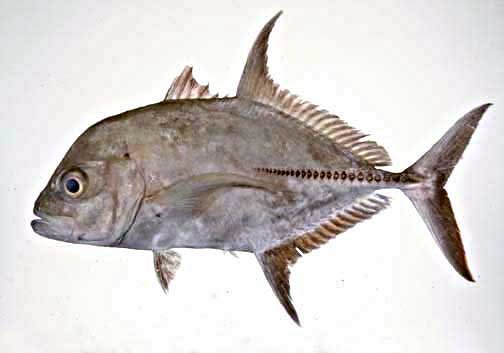
The
midline stretches from
its middle backwards,
not as in the kahi
glyph type stretching
all the way from head to
tail. This
characteristic trait
must have been well
known to all the
inhabitants on Easter
Island. Therefore the
reversed orientation in
the kahi glyph
type certainly was meant
to catch the attention
of the reader - it is a
separate sign ... |
...
It cannot be a
coincidence, I
think, that the
mythological stone
fish from Easter
Island has three
lines and a dark
square above:
The
dark square is the
entrance to a
hare paega
formed as the dorsal
fin of the fish. The
entrance to a
hare paega is
normally not exactly
square but the
resemblance is
close:
Crawling in through
the entrance head
goes first and it
becomes completely
dark, because the
eyes are calibrated
for the outside
light and the body
is blocking the
opening ...
... Above
and below are
primary concepts.
Above is the sky
with its light
sources and below,
under the surface of
the earth, there is
water. The surface
of the earth is like
a line between two
kingdoms, that of
fire and that of
water. The haddock
line can be imagined
as a picture of the
surface of the
earth.
For
the Polynesians,
living in the
tropical belt, it
must early have
become evident that
the haddock image
was wrong. It is not
so simple as a light
hemisphere above and
a black below. The
two hemisphere are
alike, not
different. When sun
visits one
hemisphere it
becomes dark in the
other and half a
year later the
situation is
reversed.
I
guess the three
lines along the
sides of the stone
fish illustrate the
tropical belt with
equator in the
middle.
The
back side of the
fish has a hare
paega because
the bottom shows sun
is located south of
the equator - three
balls identify his
location. With sun
present (in front)
the back of couse
must be in the
shadow.
Sun
is male and the
shadow is female. A
house is dark inside
and a house is
female. At midsummer
we pass from sun in
front into the
shadows.
Sun
is 'born' for us in
the darkest of
times, e.g. at
midnight. If he
visits both north
and south in equal
amounts during one
of his cycles, then
the inference is
that he must 'die'
when light reaches
its maximum (e.g. at
noon).
Realizing that north
and south are
equally good
habitats ('wives')
for the sun - that
'fire' is present
half the time also
south of the equator
- should transform
the idea of a single
sun cycle for the
year into a concept
of two sun cycles.
By
redefining the
'birth' and 'death'
of sun from spring
equinox respectively
autumn equinox to
'midnight'
respectively 'noon',
the pattern of the
primary time giver
(moon) was applied
also for the sun.
Instead of thinking
summer contra winter
we must think waxing
contra waning.
The
stone fish has his
jaws in front, he
grows by eating. The
final (tail end) is
designed like a
death skull:
Picture at left is
the front end of the
sun fish, with teeth
showing. From this
perspective hare
paega is looking
like a nose. An
umu adjoins the
hare paega
(fire is outside,
not inside), and its
hole is here looking
like the red topknot
of a moai
statue. The umu
comes closer to the
end than hare
paega, because
it is not necessary
to light a new sun
fire already at
'noon'.
In
the picture at right
the tail end shows
how the nose has
disappeared and a
rhomb has taken its
place. Teeth are
formed by the ends
of the double set of
three lines running
along the sides of
the body...
|
...
In Ko Koró
(December) new
houses are being
occupied, and
possibly it alludes
to how sun at
midsummer is going
to put his head into
the opening of a 'hare
paega'. Barthel
has coordinated
Ko Koró with
Pua Katiki and
Maunga
Teatea. Pua
means ginger (and
flower), and like
insects sun is
visiting his
'flower' - putting
his head in. Not
even we in our deaf
civilization can
miss that point
(bees and flowers).
East
is black and west is
white and in the
west moon is rising,
gradually showing
her white (tea)
face. Maunga
Teatea is a
suitable name for
the first station
beyond - when sun
has left ...
|
The spring shark, with a very long
'nose' has reached his goal. The
Devil he is (according to the
missionaries). It is necessary to
repeat earlier insights which tend
to fade from memory.
...
The dream soul went on and came to
Tama. She named the place 'Tama',
an evil fish (he ika kino)
with a very long nose (he ihu
roroa) ...
|
Te Pei
In Barthel 2 the pe'i
fish has been compared with
the Maori word pei,
'to drive out, banish'. It
is a 'tasty fish' caught in
'deep waters'. Possibly it
has been driven there from a
higher position, because the
time is high summer - from a
top position a quick dive to
the lowest. What has
happened can be imagined as
a pei-āmo ride.
Pei = 'Grooves, still
visible on the steep slopes
of some hills, anciently
used as toboggans. People
used to slide down them
seated on banana-tree barks.
This pastime, very popular,
was called pei-āmo.'
Sun has matured into a grown
man and been initiated into
the mysteries of life. He
has been reborn in the
process and now moves on by
following the moon. The
connection with Rano
Kau is evident and
Te Pei is the natural
development following after
Te Poko Uri ('the
dark abyss') - while Nga
Kope Ririva is a 'zero',
an interlude.
 |
 |
 |
 |
|
Ga8-17 (221) |
Ga8-18 |
Ga8-19 |
Ga8-20 |
 |
 |
 |
Haś
in Ga8-23
has 5
'feathers'
at left,
i.e. 5
('fire')
stations of
spring sun
are in the
past. |
|
Ga8-21 |
Ga8-22 |
Ga8-23 |
 |
 |
 |
 |
|
Ga8-24 (228) |
Ga8-25 |
Ga8-26 |
Gb1-1 |
 |
 |
 |
 |
|
Gb1-2 (232) |
Gb1-3 |
Gb1-4 |
Gb1-5 |
 |
 |
 |
 |
|
Gb1-6 (236) |
Gb1-7 |
Gb1-8 |
Gb1-9 |
 |
 |
 |
 |
|
Gb1-10 (240) |
Gb1-11 |
Gb1-12 |
Gb1-13 |
 |
 |
 |
 |
|
Gb1-14 (244) |
Gb1-15 |
Gb1-16 |
Gb1-17 |
 |
 |
 |
 |
|
Gb1-18 (248) |
Gb1-19 |
Gb1-20 |
Gb1-21 |
 |
 |
 |
 |
|
Gb1-22 (252) |
Gb1-23 |
Gb1-24 |
Gb1-25 |
The 5 'fire' (spring
sun) stations
(months) in the past
(cfr Ca8-23)
presumably are Te
Piringa Aniva,
Te Kioe
Uri, Te
Manavai, Te
Poko Uri, and
Te Pu Mahore.
The glyph type
haś usually
indicates where a
season ends.
Therefore the 4
glyphs following
each measure (8 *
29.5 = 236 etc)
apparently belong to
respectively
redmarked 'measure'
glyph above in the
table.
248 * 2 = 496 (= 16
* 31) probably is
the highest such
'measure'. Gb1-22
(with 22 probably
alluding to π) does
not belong to the
group of 6 * 4 = 24
glyphs connected
with Te Pei.
The extraordinary
Gb1-21 is the last
glyph.
The group of 4
glyphs beginning
with Gb8-24
straddles the border
between side a and
side b. 8 * 24 =
192, a number equal
to the number of
glyphs in the K text
(which covers only
the 'dark', uri,
side). 228 = 8 *
28½, is possibly
indicating the
border line between
those 28 nights when
moon is being
illuminated by sun
and the following
dark 29th night.
With 8 * 29 = 232 a
'new moon time' has
arrived and the
'head' has gone. The
empty 'eye socket'
(where the sun disc
should have been) is
illustrated like a
navel in the
following Gb1-3, as
if in expectation of
the new sun child to
arrive.
The bird with
undulating wings in
Gb1-4 stands at
position 13 * 18 =
234. Together with
the following
tagata it marks
the end of the old
season. At bottom
right (in Gb1-5)
there is a sign like
an apex, the sun
maximum is arriving.
The turnover is
illustrated in
Gb1-6--7 (from 6,
sun, to 7, moon).
236 = 472 / 2, i.e.
Gb1-6 is the last of
the sun glyphs. The
head of the sun
comes off (hore)
and it becomes dark.
|
Hore
(Hore,
horehore):
to
cut with a
knife or
with an
obsidian
blade (also:
horea).
Horeko,
solitary,
lonely;
kona horeko,
solitary
place,
loneliness.
Vanaga.
To hew, to
cut off, to
amputate, to
castrate, to
cut with a
knife, to
decapitate,
to abridge,
to incise,
to set
landmarks; a
notch,
incision,
tenon;
hore poto,
to cut short
off; hore
te gao,
to chop the
head off.
Churchill. |
In sun 'measure' the
same message is told
in Gb1-10 (with
ordinal number 8 *
30 = 240 instead of
8 * 29.5 = 236). The
head is still there
at left but at right
it has gone.
In Gb1-13 spring sun
(the 'eater') is
inverted, with
vae at left - he
has gone down. The
following glyph (244
= 8 * 30½) initiates
the new sun season.
Hua poporo
lies ahead, the
'fruits' of the
conjunction between
spring sun and
earth.
Not until 8 * 31
(day 248) is 'noon'
assuredly reached
(according to the
longest measure,
based on 31). It
ends with the
exceptional Gb1-21
(at 252 = 7 * 36).
|
The argumentation centers on summer
solstice as the end of spring sun.
According to the moon calendar 8
months have been measured out
(counted from Gb8-30 - where 8 * 30
= 240 possibly serves as a cue). The
full cycle is 16 months, where we
find a tamaiti with a droplet
at bottom.
The ordinary sun calendar is not
relevant. We must use the 400-day
long one:
 |
 |
 |
70 |
219 |
 |
 |
 |
|
Gb6-17 (400) |
Gb6-18 |
Gb6-19 |
Ga8-16 |
Ga8-17 |
Ga8-18 (222) |
|
295 |
If we instead begin at tamaiti
in midwinter:
 |
 |
 |
 |
57 |
219 |
 |
 |
 |
|
Gb7-1 (412) |
Gb7-2 |
Gb7-3 |
Gb7-4 |
Ga8-16 |
Ga8-17 |
Ga8-18 (222) |
|
280 |
 |
57 |
235 |
 |
 |
|
Gb7-4 |
Gb1-6 |
Gb1-7 (237) |
|
295 |
With Te Pei at 8 * 29.5 =
236, the measure of 8 lunar months
is full. At Tama (Gb7-3)
likewise a measure is full. A new
measure will begin from Gb7-4:
 |
 |
57 |
180 |
 |
 |
53 |
 |
 |
|
Gb7-3 (414) |
Gb7-4 |
237 |
Ga7-11 (181) |
Ga7-12 |
Gb1-6 |
Gb1-7 (237) |
|
240 |
55 |
|
295 |
Ika hiku in Ga7-12 indicates
the full measure for the sun of
spring. 237 days between Gb7-4 and
Ga7-11 is only a consequence of the
measure 240 and my positioning of
the two tamaiti glyphs in
pairs with the following ones. It is
not necessarily a cue embedded in
the text to look for glyph number
237 counted from Gb8-30.
Counted from Gb8-30 tamaiti
in Ga7-11 serves as a mark for the
beginning of the 2nd half of 360
days:
 |
 |
178 |
 |
 |
176 |
 |
 |
|
Gb8-30 |
Ga1-1 |
Ga7-11 (181) |
Ga7-12 |
Gb5-5 |
Gb5-6 (360) |
|
180 |
180 |
Ika hiku at Ga7-12 is number
182 counted from Gb8-30 (half 364) =
number 58 + 182 = 240 counted from
Cb7-4.
|




